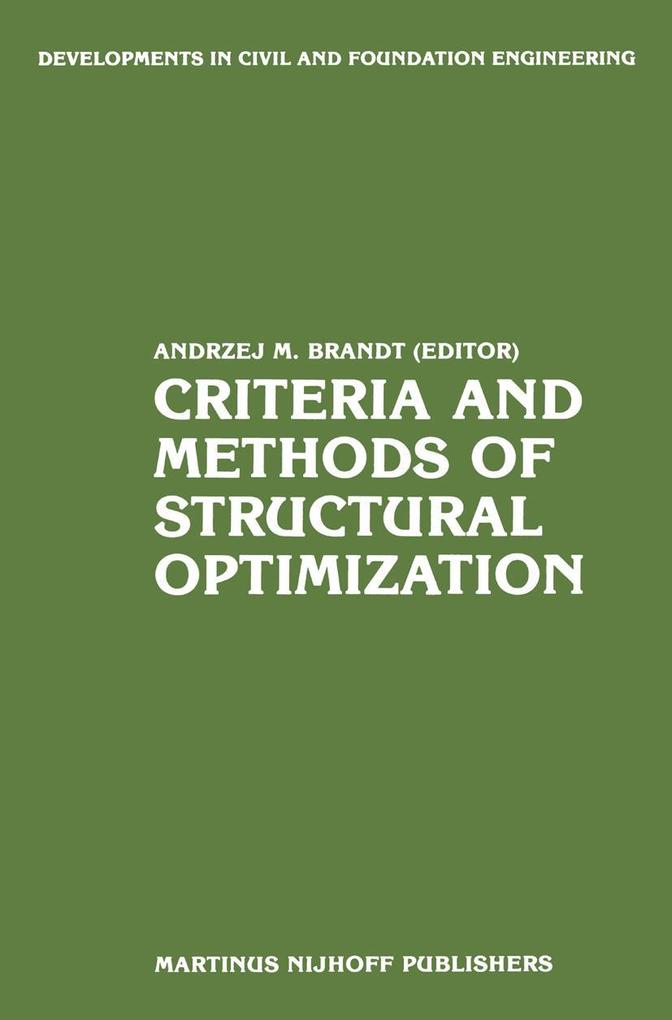This book is intended to serve all those who are interested in structural opti mization, whether they work in this field or study it for other purposes. Rapid growth of interest in the cognitive aspects of optimization and the increas ing demands that the present day engineer has to meet in modern design have created the need of a monographic treatment of the subject. The vast number and wide range of structural optimization problems formulated and investigated in the last twenty years call for an attempt to sum up the pres ent state of knowledge in this domain and to outline the directions of its further development. The present authors undertook this task, hoping that the result would stimulate further work towards finding new methods and solutions and increasing the range of applications of the optimization methods to structural design. The immediate aim of the book is to present the basic criteria and methods of optimization and to provide a reference guide to the most important publications in the field. 'The book consists of fourteen chapters. Chapter 1 introduces the basic concepts, definitions and assumptions relating to structural optimization. Chapter 2 gives the foundations of optimization for minimum elastic strain potential or maximum rigidity, and sets a basis for optimization of bar, plate and lattice structures. Chapter 3 presents criteria of strength design and their applications to plane structures.
Inhaltsverzeichnis
I: Criteria of Structural Optimization.- 1 Aims, Basic Concepts and Assumptions.- 1.1 The aims and scope of optimization.- 1.2 Basic concepts and definitions.- 1.3 Preliminary assumptions.- 2 Optimization for Minimum Potential Energy, Maximum Rigidity and Minimum Deformability.- 2.1 The optimality criterion.- 2.2 Wasiuty?ski s theorems.- 2.3 Deformability of a structure and the free surface.- 2.4 The necessary and sufficient conditions of minimum deformability.- 2.5 Optimization of plane bar structures.- 2.6 Optimization of plates.- 2.7 Optimization of spatial lattice bar structures.- 3 Uniform Strength Design.- 3.1 Strength hypotheses.- 3.2 The criterion of uniform strength.- 3.3 Uniform-strength design of structures under multiple loading conditions.- 3.4 Uniform-strength design of bar structures.- 3.5 Uniform-strength design of beams with cross-sections defined up to m parameters.- 3.6 Uniform-strength design of plates.- 4 Optimization for Minimum Volume, Weight or Cost.- 4.1 The criterion of optimization.- 4.2 Optimum elastic design.- 4.3 Examples of optimum elastic design.- 4.4 Optimum limit design.- 4.5 Examples of optimum limit design.- 4.6 Probabilistic approach to optimum design.- II: Methods of Structural Optimization.- 5 Introduction to Mathematical Methods of Optimization.- 5.1 Problem formulation in optimum structural design.- 5.2 Classical extremum theory.- 5.3 Convex regions and convex functions.- 6 Linear Programming.- 6.1 The linear programming problem.- 6.2 Constrained extrema of a linear function.- 6.3 The graphical method of linear programming.- 6.4 Determination of an initial basic feasible solution.- 6.5 The simplex method.- 6.6 Duality in linear programming.- 6.7 Other important methods of linear programming.- 6.8 Linear discrete programming.- 6.9 Examples of linear programming in optimum structural design.- 7 Non-linear Programming.- 7.1 Problem statement.- 7.2 Kuhn-Tucker conditions.- 7.3 Quadratic programming.- 7.4 Duality in quadratic programming.- 7.5 Beale s method.- 7.6 Wolfe s method.- 7.7 Geometric programming: unconstrained problem.- 7.8 Geometric programming: constrained problem.- 7.9 Non-linear integer programming.- 7.10 Unconstrained optimization: direct search methods.- 7.11 Unconstrained optimization: descent methods.- 7.12 Constrained optimization: direct methods.- 7.13 Constrained optimization: indirect methods.- 7.14 Choosing a method.- 7.15 Applications of non-linear programming methods to structural optimization.- 8 Dynamic Programming.- 8.1 Introduction.- 8.2 Multi-stage decision process.- 8.3 Bellman s principle of optimality.- 8.4 The variant method of dynamic programming.- 8.5 Applications of dynamic programming to structural optimization.- 8.6 Final to initial value problem conversion.- 8.7 Continuous dynamic programming.- 9 Stochastic Programming.- 9.1 Linear stochastic programming.- 9.2 Non-linear stochastic programming.- 9.3 Reliability-based structural optimization: a stochastic programming approach.- 10 Classical Variational Methods. Examples of Application to Optimum Structural Design.- 10.1 Introductory remarks and fundamental concepts.- 10.2 Necessary conditions for an extremum of a functional.- 10.3 Variational problems with side conditions.- 10.4 Sufficient conditions for a minimum of a functional.- 10.5 Direct methods in the calculus of variations.- 10.6 Examples of application of the calculus of variations to structural optimization.- 11 Non-classical Variational Methods of Optimization.- 11.1 Assumptions and problem formulations.- 11.2 Optimality conditions: necessary and sufficient.- 11.3 Trukhaev-Khomenyuk operator equations.- 11.4 Elimination of inequality constraints.- 11.5 Minimax formulation for non-classical variational problems.- 11.6 Approximate methods for non-classical variational problems.- 12 Mathematical Theory of Extremum Problems.- 12.1 Introduction.- 12.2 Cones and dual cones.- 12.3 Necessary extremum conditions.- 12.4 Directions of decrease.- 12.5 Feasible directions.- 12.6 Tangent directions.- 12.7 Calculation of dual cones.- 12.8 The Lagrange multiplier rule and the Kuhn-Tucker theorem.- 12.9 Optimal control problems. Local maximum principle. Pontryagin maximum principle.- 12.10 Sufficient extremum conditions.- 13 Iterative and Experimental Methods of Shape Optimization of Structures.- 13.1 Iterative and experimental approaches to shape optimization.- 13.2 Types of iterations.- 13.3 Iteration vs. imitation and the trial and error method.- 13.4 Designing a column for uniform strain.- 13.5 Designing an arch bridge for uniform strain.- 13.6 Determination of an optimum profile of the junction between a beam and a column by means of photo-elastic modelling.- 13.7 Determination of the optimum shape of plane structures.- 13.8 Shape optimization of shells.- III: Bibliographical Survey and Bibliography.- 14 Survey of the Literature of Structural Optimization.- 14.1 Scope and aim of the survey.- 14.2 Survey works and general studies on structural optimization.- 14.3 Optimization of beams.- 14.4 Optimization of plates.- 14.5 Optimization of trusses.- 14.6 Optimization of columns, arches and frames.- 14.7 Optimization of shells, hanging structures and lattice structures.- Bibliography of Structural Optimization.- Author index.










